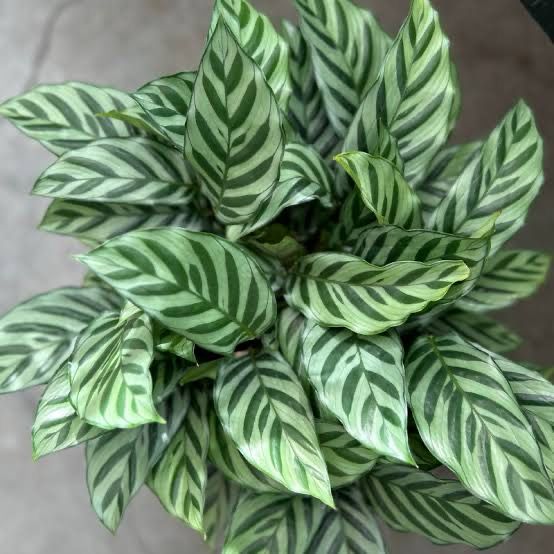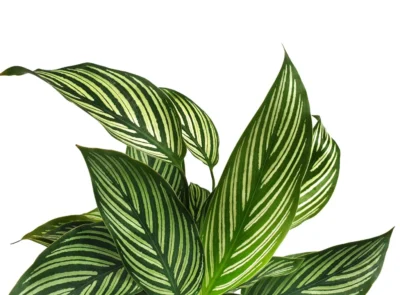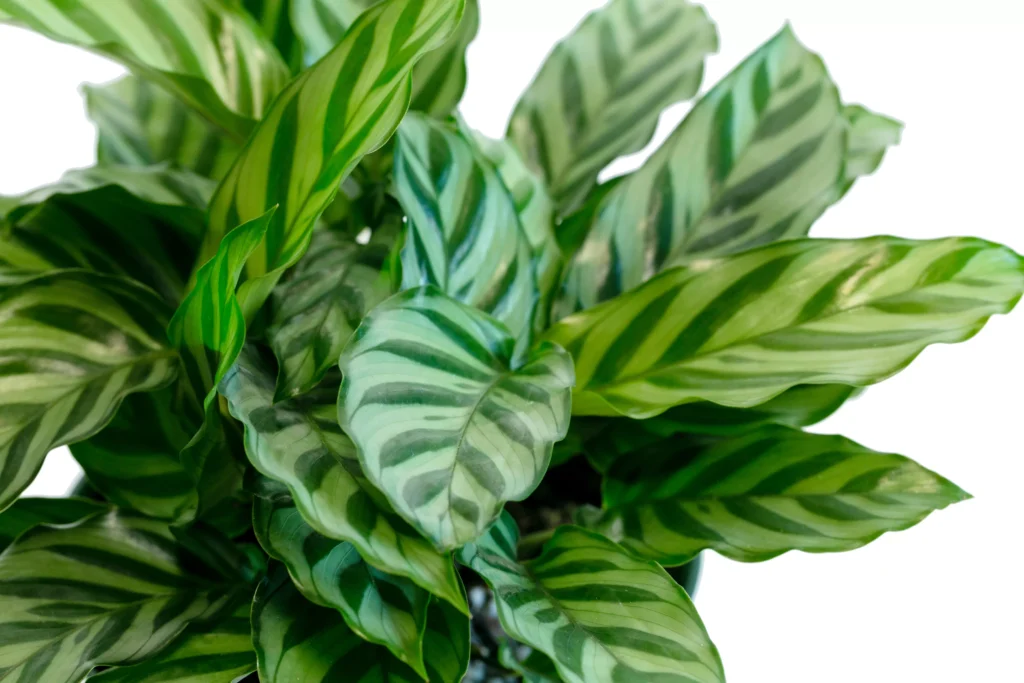How to Keep Your Calathea ‘Freddy’ Happy and Healthy

Introduction
Calathea ‘Freddy’, a member of the prayer plant family. It has been stealing the hearts of plant enthusiasts worldwide. This striking plant is known for its mesmerizing foliage and unique characteristics. It offers a blend of beauty and intrigue for novice and experienced plant lovers.
The plant is native to the tropical regions of South America. Calathea ‘Freddy’ belongs to the Marantaceae family. This family includes plants known for their leaves and the genus Goeppertia (Calathea). This particular cultivar stands out with its distinctive striped pattern and eye-catching coloration.
The popularity of Calathea ‘Freddy’ is due to several factors:
- Striking Foliage: Its leaves feature a pattern of green stripes, creating a spectacle.
- Nyctinasty: Calathea ‘Freddy’ exhibits movements. Raising its leaves at night and lowering them during the day.
- Air-Purifying Properties: It helps improve indoor air quality by removing certain pollutants.
- Compact Size: Its manageable size makes it suitable for various indoor spaces.
- Low Light Tolerance: It prefers indirect light, it can adapt to lower light conditions.
You’ll discover the intricacies of its care, and its unique characteristics. This guide gives you the knowledge for your Calathea ‘Freddy’ to thrive. It will become a stunning centerpiece in your indoor garden.
We’ll explore every aspect of Calathea ‘Freddy’ care. Its specific needs to advanced growing techniques. You’ll have all the tools necessary to cultivate a healthy, vibrant Calathea ‘Freddy’.
Characteristics of Calathea ‘Freddy’
Understanding the unique characteristics of Calathea ‘Freddy’ for appreciation and proper care are key. We will look at the appearance, unique features, and how it compares with other Calathea.
Physical Appearance
Calathea ‘Freddy’ is known for its foliage, which sets it apart from many other houseplants:
- Leaf Shape and Size:
- Shape: Oval to lance-shaped leaves
- Leaf Patterns:
- Distinctive alternating light and dark green stripes
- Stripes run parallel to the leaf’s central vein
- Underside of leaves often displays a purple hue
- Plant Size and Growth Habit:
- Mature height: Usually reaches 1-2 feet (30-60 cm)
- Spread: Can grow to about 1-1.5 feet (30-45 cm) wide
- Growth habit: Clumping, forming a bushy appearance
Unique Features of Calathea ‘Freddy’
Calathea ‘Freddy‘ possesses several characteristics that make it stand out:
- Nyctinasty: Like other prayer plants, Calathea ‘Freddy’ exhibits leaf movements. The leaves rise upward at night, resembling praying hands, and lower during the day.
- Color Variations: Consists of green stripes, leaves display subtle pink or reddish tones.
- Texture: The leaves have a velvety texture, adding to the plant’s appeal.
- Air Purification: The Calathea species remove air pollutants, contributing to a healthier environment.
Comparison to Other Calathea Varieties
Key Differences:
- Pattern Consistency: Calathea ‘Freddy’ has a uniform striping pattern.
- Color Scheme: Some Calatheas feature bold pink or red.
- Leaf Shape: ‘Freddy’ has broader leaves.
“Each Calathea variety tells its own story through its unique patterns and colors.” Freddy’ narrates a tale of subtle elegance with its harmonious green stripes.” – Maria Rodriguez, Botanical Garden Curator
These characteristics enhance your appreciation for Calathea ‘Freddy’. They help identify healthy specimens and monitor your plant’s growth. We’ll explore how to cater to these unique traits through proper care and maintenance.
Characteristics of Calathea ‘Freddy’
Detailed Leaf Structure
The leaves of Calathea ‘Freddy’ are striking and interesting:
- Venation: Leaves feature a central vein (midrib) branching in a feather-like pattern. Venation is not aesthetic it plays a role in water and nutrient distribution.
- Leaf Margins: The edges of the leaves are smooth (entire). Some other Calathea species have wavy or ruffled margins.
- Leaf Thickness: The leaves are thick, which store moisture.
Growth Patterns and Life Cycle
Understanding the growth patterns of Calathea ‘Freddy’ can help in providing optimal care:
- Growth Rate: Calathea ‘Freddy’ is a moderate grower. Under ideal conditions, you can expect:
- New leaf emergence: Every 4-6 weeks during the growing season
- A mature plant may produce 10-15 new leaves per year
- Life Cycle Stages:
- Juvenile Stage: Characterized by smaller, more delicate leaves
- Mature Stage: Developed leaf size and pattern intensity
- Dormancy: Reduced growth during winter months
- Seasonal Variations:
- Spring/Summer: Peak growth period with more vibrant colors
- Fall/Winter: Slower growth, need adjusted care
Physiological Adaptations
Calathea ‘Freddy’ has evolved several adaptations that contribute to its unique characteristics:
- Photonasty: The ability to move its leaves is a result of specialized pulvini at the base of each leaf. This movement optimizes light absorption and manages moisture loss.
- Stomatal Distribution: Calathea has stomata on the underside of their leaves. This adaptation helps reduce water loss in their native humid environments.
- Pigmentation: The purple underside of the leaves is due to anthocyanin pigments. They aid in light absorption and protection against excess light.

Genetic Background and Cultivation
The genetic origins of Calathea ‘Freddy’ are not published. It’s believed to be a cultivar developed through selective breeding:
- Parent Species: Derived from Calathea (now Goeppertia) concinna or a related species
- Cultivation History: Developed in the Netherlands, a plant breeding hub
- Genetic Stability: Calathea ‘Freddy’ is propagated through division to maintain its distinctive characteristics
Caring for Your Calathea ‘Freddy’
Optimal care for your Calathea ‘Freddy’ is crucial for its health and its foliage. This section will cover aspects of care, from light requirements to maintenance practices.
Light Requirements
Calathea ‘Freddy’ thrives in bright, indirect light.
Ideal Light: Bright, filtered light is best. Place your plant near a north or east-facing window.
- Avoid Direct Sunlight: Direct sun scorches the leaves, causing brown spots.
- Low Light Tolerance: ‘Freddy’ can tolerate lower light conditions. It’s growth may slow, and the leaf patterns may become less pronounced.
Watering Needs
Proper watering is critical for the health of your Calathea ‘Freddy’. These plants prefer consistent moisture but are susceptible to root rot if overwatered.
- Frequency: Water when the top 1-2 inches of soil feels dry to the touch.
- Method: Water until it drains from the bottom of the pot, then empty the saucer.
- Water Quality: Use distilled rainwater, or filtered water to avoid mineral buildup.
Soil and Potting Mix
Calathea ‘Freddy’ requires a well-draining, airy potting mix that retains some moisture.
Ideal Potting Mix Recipe:
- 1 part peat moss or coco coir
- 1 part perlite or pumice
- 1 part orchid bark
- 1/2 part activated charcoal
This mix provides:
- Good aeration for root health
- Adequate moisture retention
- Excellent drainage to prevent waterlogging
PH Level: Aim for an acidic to neutral pH (6.0-7.0)
Temperature and Humidity
Calathea ‘Freddy’ thrives in warm, humid conditions.
- Temperature: Ideal range is 65°F to 80°F (18°C to 27°C)
- Humidity: Prefers high humidity, 60% or above
To increase humidity:
- Use a pebble tray filled with water
- Group plants together
- Run a humidifier nearby
- Mist the leaves often (but avoid water sitting on leaves for extended periods)
Fertilizing Your Calathea ‘Freddy’
Regular fertilization during the growing season promotes healthy growth and vibrant foliage.
- Frequency: Feed every 4-6 weeks during spring and summer
- Type: Use a balanced, water-soluble fertilizer (NPK 10-10-10)
- Application: Dilute to half-strength to avoid fertilizer burn
Caution: Over-fertilization can lead to salt buildup and root damage. If in doubt, it’s better to under-fertilize than over-fertilize.
Pruning and Maintenance
While Calathea ‘Freddy’ doesn’t need pruning, some maintenance keeps it looking its best.
Pruning tasks:
- Remove any yellow or damaged leaves at the base of the stem
- Trim brown leaf edges with clean, sharp scissors
- Remove any dead or decaying matter from the soil surface
Maintenance tips:
- Dust leaves with a damp cloth to keep them clean and photosynthesizing
- Rotate the plant quarterly to ensure even growth
- Check for pests during routine care, especially under the leaves
Annual Care Checklist:
- Repot if necessary (usually every 2-3 years)
- Clean and inspect pot and drainage holes
- Refresh top layer of soil
- Deep clean leaves
- Check for and treat any pest issues
These care guidelines create an environment where your Calathea ‘Freddy’ can flourish. Its beautiful striped foliage will become a true centerpiece in your garden. Consistency is key with Calatheas – they thrive on routine care and stable conditions.
Conclusion

Caring for Calathea ‘Freddy’ is a rewarding experience that brings a tropical elegance. This stunning prayer plant requires attention to detail. The effort is worth the payoff of its striped foliage and nyctinastic movements.
Key takeaways for successful Calathea ‘Freddy’ care include:
- Providing bright, indirect light to maintain vibrant leaf patterns
- Maintaining consistent soil moisture without overwatering
- Ensuring high humidity levels to mimic its native tropical environment
- Using appropriate soil mix for proper drainage and aeration
- Regular careful fertilization during the growing season
- Gentle maintenance practices like dusting leaves and occasional pruning
Each Calathea ‘Freddy’ may have its quirks, and it’s important to observe your plant and adjust care. Patience and consistency are key when cultivating this beautiful species.
Calathea ‘Freddy’ offers a perfect blend of challenge and reward.